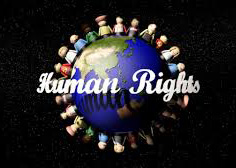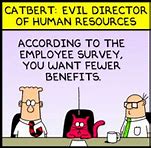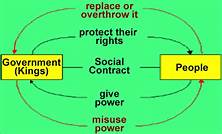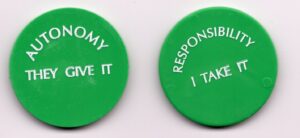
Human Rights and Plan B
The term “Human Rights” (HR) is a member of the category of words protected from objective definition by the ruling class. The official definition, “Human rights are moral principles or norms that describe certain standards of human behavior, and are regularly protected as natural and legal rights in municipal and international law” is not helpful to a Plan A bait-ball captive denied those rights.
Unalienable human rights supersede governmental laws and cultural norms. These natural rights include the right to think for oneself, the right to life, and the right to self-defense, and they remain through every human’s lifetime. Legal rights, on the other hand, are those created, acknowledged, and protected by a government. Everyone knows about the two-tier system of legal rights.
The “human rights” matter has a long turbulent history. Since Aristotle, and with few exceptions, it has been hierarchical society elites over individual-freedom rights. Since social policy has assumed people must fear divine retribution to be ruled, the hierarchy is presented in social conditioning as a supernatural power, one that empowers it to deny human rights and force obedience to authority. It features a communication network based on value, not fact; intention, not results; judgement not proof. Social action exhibits a maelstrom of subconscious reflexes, mutually incongruent.
Today, under Plan A, academia has taken over from religion as the primary institution of moral instruction. In Plan B, no losers and dedicated to human flourishing, no one is “ruled.” Your human rights are animated by a culture of independence for responsibility, a spirit of liberty that brings them to life. This is necessary to minimize the lag between a changing reality and its apprehension.
Our “rights” is a category of social behavior that also includes leadership, trust, and obedience. These words of social process and networked-mind dynamics represent concepts residing in the subconscious mind that are reflex-driven – “I’ll know it when I see it.” To marooned Crusoe, the terms in this broad category, also including faith, safety, welfare, security, and liberty, had no relevance to his personal goal to remain viable.
The compelling reason to emphasize the linkage between Plan B and our elusive human rights (HR) is as a basic strategy for dealing with the Plan B antagonists, saboteurs, and infidels at ambush in the way from Plan A to Plan B. It is coded in the “stop rules” provided in hard copy to sponsors of the FLLP. It is detailing our legal right to stop a program that can’t succeed, right in its tracks.
The wacky world of human rights provides another independent route for replacing Plan A with Plan B. It joins three other routes to Plan B equifinality in human flourishing. The logic expressed on this page is compelling on its own.
Since the intangible concept of morals-based HR is undiscussable in theory, there is no limit to the variety of vague and amorphous expressions of “human rights.” Owning your HR starts with knowing what they are and their conditions of validity. You have to learn and practice how to position your rights in HR-hostile settings, the Plan A norm. Everyone recognizes “Catbert,” the evil HR director in Dilbert who runs roughshod over inalienable rights of the employees. Scott Adams knew from experience she needed no introduction to the public at large. The pursuit of Plan B is an unalienable rioght.

As you have experienced, nothing in moral law will proactively assure realization of your HR. The ruling class defines your grade as one for which it can suspend your HR with impunity. Enjoying your unalienable rights, even in neutral conditions, takes intelligence, cunning, and eternal vigilance.
Everyone knows the history of human rights and everyone is loaded with dreadful experience with HR in practice. You know what happens to people who “fight” for particular human rights that have been taken away. You can learn here how to leverage knowledge of HR into an effective tool for shaping workforce behavior to its benefit.
The first article in the USA Bill of Rights “guarantees” you the right to redress HR grievances. There are ways to act within that article that will help clear the way to Plan B. It is not the moral code that gives you access. It is the incontrovertible set of human rights defined by invariant human nature and natural law. It is the right of Crusoe to pursue survival and to hell with everything else.
In order to separate out those human rights relevant to Plan B for use, it is necessary to structure the HR spectrum. The first three categories below are morals-based rights about which the laws of the universe are indifferent. Employ them or not, natural law does not intrude. Your human nature may care, but nature remains indifferent.
For the fourth “rights” category, below, the combination of invariant human nature and natural law establishes strict rights of social behavior that cannot and will not be defied by any species. These rights include access to Plan B, because if they are not honored, the consequences are material, lose-lose, and dire.
- Establishment declarations of unalienable rights
- Rights codified in man-law, including recourse
- Genome rights, invariant human Nature
- Instincts
- Survival
- Square deal
- Workmanship
- Instincts
- Contingent rights codified in natural law, incontrovertible
- Duty
- Outcome responsibility
- Stakeholder protection

Discussion
Organizations, just because they are collectives, have no HRs apart from those of their individuals under the social contract. Obedience to social system authorities is not a HR one way or the other. Obedience is a form of social influence in which a person yields to explicit instructions from an authority. Depending on context, obedience can be seen as moral, immoral, or amoral. Never allow obedience to override your HR. The same applies to compliance, behavior influenced by peers, and conformity, behavior intended to match that of the groupthink majority.
Part of the social behavior spectrum itself, HR is a psychological-moral phenomenon of the subconscious mind and nothing else. It is encoded in the traffic going around the network of entangled minds comprising the social system. Since it has no mass, HR has no inertia. Human rights can appear and vanish in an instant. Members of Plan A had their HR taken away when they signed on. Members of Plan B, same roster, enjoy them all. In implementation, the contrast in behavior speaks for itself about moral rights.
The Establishment handling of HR advertises a delusion that human rights have some kind of anchor in society that protects and provides them to you and that you have recourse should your rights be infringed. Nothing could be further from the truth. No one and no law avers the responsibility to assure that you receive your human rights. Others may compose them for you and law may appear to “protect” some of them, but only you can enforce living your human rights and only for yourself. The only guardian of HR for you is you.
The only anchor that works for you automatically is the contingent rights enforced by natural law. When the head-shed attempts to deny you these rights, like any attempt to defy natural law, is automatically punished. Trust is gone. No trust, no prosperity.
Human rights and Fundamental Freedoms
Declaration of Independence, 1776, Bill of Rights (1789)
- Life, liberty, and the pursuit of happiness, DOI
- To petition for redress, BoR
UN Universal Declaration of Human Rights (1948)
- DOI plus the security of person
- No punishment, degrading treatment
- Competent and effective remedy for violations
- Hold opinions without interference or abuse
- Seek, receive, and impart information unopposed
- Strive towards psychological success
- Just and favorable conditions of work
- Form unions to protect rights
- Protection of intellectual property
- Duty to community welfare
Commentary: The HRs listed above are well known, even as their record of compliance is atrocious. The declarations changed nothing in the systematic withdrawal of HR by the ruling class against the working class. While Eleanor Roosevelt got the declaration ratified, she couldn’t get it implemented.
Rights codified in man-made law, including recourse
- Tort
- Stakeholder protection
- Equitable estoppel
- Conditions of professional license (keystone PEs)
- Refusal to engage unlawful activities. Avoid crime of obedience
- Protect stakeholders
Commentary:
Suspending your rights, under the law, is only actionable when material damage results. If the suspension only damages your self-image, too bad. The primary means for redress of material damage is tort.
While tort evolved centuries ago in England as a legal recourse for disputes between members of the ruling class, it has become a general means for a plaintiff to recover damages inflicted by a defendant. It prevents the defendant from escaping responsibility by pleading ignorance. It is your right to fair treatment by others.
Equitable estoppel prevents the ruling class from assigning obligations and conditions for meeting them and then change one or the other or both and punishing you for failure to deliver. This is, perhaps, the most frequent of Plan A HR violations.
The conditions of professional license are published rights of the stakeholders of the profession for protection in exchange for autonomy granted the professional to do his work as he sees fit. The professional engineer is required to know when a project is going to fail, take remedial action, and failing that, withdraw from the engagement. Since all keystones are de facto doing engineering functions, the same conditions apply. Freedom to act means release from obedience to authority.
Genome rights, Human Nature Instincts
- Survival, health
- Opportunity for psychological success
- Square deal
- Reciprocity
- Innovation
- Workmanship
Commentary:
The amount of punishment, in suppressed instincts, has no bearing on the natural right of those instincts. The instincts may hide but they do not go away. You cannot usurp an instinct. Suppressing an instinct breeds distrust and angst.
The right to life is number one in the DOI. You have a right to protect yourself from life-threatening harm. While nobody quarrels with the principle, it is a right routinely cast aside by industrialization. The history of the industrial revolution is the history of occupational toxicity, disregard for worker safety, and unbridled damage to the environment.
The right to a square deal is a deeply-held instinct that includes fairness and justice. When this instinct is violated, trust goes out the window.
The instinct of reciprocity swings both ways. In Plan A, the reflex against the unsquared deal brings Ca’canny. In Plan B, positive reciprocity is the norm and the queen of social behavior.
Creativity is as natural an instinct as any of them. Everyone enjoys expressing their creativity. When the head shed squashes workforce creativity in the name of obedience, it loses a creative force multiplier of at least twenty. In Plan B, innovation is encouraged. It’s how, exactly, problems get solved. It is how competitive advantage is maintained.
The instinct of workmanship is a fundamental of human nature. To thwart this instinctual right is to demoralize the workforce. Negative reciprocity is the result. The champion of productivity over short-sighted profiteering was Thorstein Veblen. In his The Instinct of Workmanship and the State of the Industrial Arts (1914), he elaborated on his thesis that business enterprise was in fundamental conflict with the human for useful effort; too much of humankind’s energy was being wasted through inefficient institutions.
Rights codified in natural law, incontrovertible
- Contingent rights, conditional
- Acquired obligations
- Duty of effort
- Outcome responsibility
- Stakeholder protection
- Acquired rights of accessibility and independence to attain objective
- Acquired obligations
Commentary:
There is a clear line between rights and the impossible. If the right you claim is impossible to be realized, you are delusional. Warfield’s dictum rules: “Never ask them to do what they can’t.” You have no right to claim anything that’s impossible to obtain as rights.
These are the HRs that emerge automatically with the duties, responsibilities, and obligations taken by members of a hierarchy by virtue of their role. You cannot assign responsibility for results and deny access and the independence of action necessary to fulfill duties and responsibilities, including Plan B trust building.
By taking outcome responsibility, you gain the right and freedom to use the best available means to meet your legal obligations. Especially when it’s the only way to meet the goal (e.g., safety, prosperity), you have the right to acquire and implement Plan B without obstruction.
The rationale for these conditional rights is that to deny them means failure to attain the goal. The tougher the challenge, the more essential becomes independence, autonomy, and liberty for goal-seeking. When management overrules the right to exchange responsibility for autonomy, it forfeits the possibility of organizational prosperity. Note that it doesn’t care.
Whatever you do, it’s a serious matter to let the ruling class have it both ways with your HR. The head shed sets you up to fail your role and to shoulder the blame for your failure. The strategy that works for this all-important issue is silence-breaking the truth in your bubble and quietly letting the knowledge get around in your environment. You make a stand on natural law, incontrovertible, and when the ruling class backs off, and it will, it is noticed by your social environment. The rest is on automatic.
Your argument for Plan B and defensive position is that some rights are contingent upon the particular duty and responsibility for results associated with a role in the hierarchy and that these rights are enforced by Nature Herself, independent of the social species or place in the universe – incontrovertible.
Rudolf Starkermann illuminated the connection between natural law and the duties and responsibilities of hierarchical role using control theory. The overriding principles (rights) that he derived for compliance to a role, using mathematical physics, include:
- Accessibility to the goal
- Freedom and independence to strive towards the goal
- Using the best available technology

These requisites, since they are incontrovertible, become standardized stop rules – the principal means by which we enforce our rights. Of course it has to be possible in the operational reality for you to fulfill your role to reach the goal. You require accessibility to the resources and the pathway it takes to attain it. The head shed role cannot be responsible for prosperity because the 2½ rule denies the access to the requisite information – the MitM has it. The laborer cannot be responsible because he does not have the freedom to choose his tasks – the MitM does that based upon the information he has.
This gambit turns the rights of the MitM role to increase organizational prosperity into a defensive zone where he can function as he is duty-bound by the social contract. We use the talisman to signify the social contract of the MitM role. When incontrovertible rights are abridged, the duty and responsibility associated with the role is forfeited.
The strategy associated with this noble truth is quiet, unhurried education of your social environment to human rights in general and your expression of your rights embedded your non-negotiable stop rules in particular.
Views: 205

